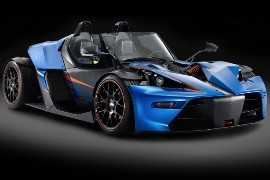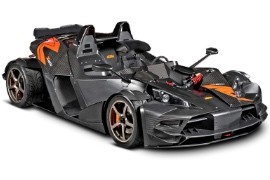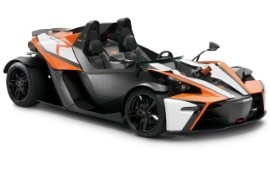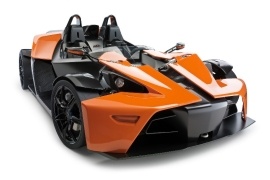KTM X-Bow Models/Series Timeline, Specifications & Photos
First production year: 2008
Engines: Gasoline
Body style: Convertible (spider/spyder, cabrio/cabriolet, drop/open/soft top)
The Austrian motorcycle builder KTM launched the X-Bow in 2008 as a track-weapon, feather-light two-seat roadster, and five years later, it made it better for road use.
KTM X-Bow was already notorious among race-car lovers. Its Dallara-designed, carbon-fiber roadster proved to be very fast despite its only 300 hp engine. The secret stood in the vehicle's weight, which was reduced to a ridiculous 790 kg (1740 lbs). But the driver and its passenger had to wear a helmet and a jumpsuit since there was no windscreen nor roof above the cabin.
The Austrian motorcycle manufacturer made an important upgrade for the roadster in 2013 when it decided to install a windshield and side windows but no roof. The X-Bow GT was just 57 kg (125 lbs) heavier than the original X-Bow. KTM included a mandatory windshield wiper.
Since the GT version was designed for Gran Tourismo travels, KTM introduced a set of, specially tailored handbags. Also, there were a few comfort features, such as a heating and ventilation system with controls installed on the center console. Moreover, the Austrian engineers considered installing an illuminated footwell. From inside, the three glass panels inspired a helmet-view for its occupants.
Under the hood, KTM installed the same 2.0-liter engine carried-over from Volkswagen GTI, tuned to produced 300 hp. It was paired to a 6-speed manual and sent its power to the rear wheels.
KTM tried to make its way into the four-wheel motorsport and built the RR version of its X-Bow roadster, squeezing more power from its Audi engine.
When a motorcycle maker tried to make a car, it took the motorcycling guidebook, and the result was a stripped-down, light roadster. The X-Bow (Cross-bow) was the Austrian roadster made to impress and wow the crowd, while the RR version was tuned for race-weekends. The Austrian brand built it and rented them for those who attended the KTM racing series. It wasn't cheap, but it was with rental vehicles, so drive it like you stole it principle was applied.
The X-Bow was a carbon-fiber bodied go-kart, just way bigger. Its design was very similar to the standard vehicle, but the unpainted carbon-fiber elements looked more spectacular. At the front, an orange tow-hook peaked through the front spoiler, while on the sides, the white decals that showed the vehicle version tried to tell everyone that that was not a regular, 240 hp version.
Since it was a race vehicle built for the adrenaline-seekers, the open cockpit sported a racing-seat with FIA homologation number on it. KTM included a six-point harness. Don't expect anything else than an LCD for the instrument panel, and that's exactly what KTM placed in front of the driver.
Under the hood, KTM installed the same inline-four, turbocharged four-pot engine shared with the S3 but tuned to offer up to 365 hp. That power varied from race to race and depending on the race-engineers. Its six-speed manual gearbox sent the power to the rear wheels.
The Austrian car manufacturer KTM introduced in 2011 a refreshed version of the original 2008 X-Bow, adding more power and a few tweaks to the car's look and interior.
Some people wanted to race weekend after weekend, and sometimes, a regular supercar just couldn't cut it. It was too expensive to buy, run, and maintain. So, they looked for a more affordable, logical solution. Then, the Austrian motorcycle manufacturer KTM cut a deal with Audi to buy engines and transmissions from them and talked to the American race-car engineering company Dallara to create a carbon-fiber chassis, and that was the beginning of a beautiful friendship. But the 2008 version, with its 240 PS (237 hp), couldn't keep up with the improved versions of Italian supercars. As a result, in 2011, KTM brought the improved X-Bow R.
The unique-looking X-Bow R featured a front fascia with a bow-shaped carbon fiber element that took center stage. It didn't feature a bumper. Instead, it had a lower horizontal slat connected to the bodywork's upper elements via two oblique connecting parts. As a result, the push-rod suspension system was exposed to elements and could be accessed easily. To be road-legal, the car had to have headlights, and these were mounted above a front horizontal panel in individual clusters.
From its profile, the roadster didn't have a windshield or doors. Customers had to hop in above the side elements that formed the protective tub of the vehicle. Still, they had to remove the steering wheel to sit in the driver's seat. Behind the cabin, the tall safety arches and the hunch over the engine compartment resembled more of a mid-engined race car than anything else. Finally, at the back, the automaker hung the round taillights under the panels mounted in the back while the dual exhausts peaked through a metallic plate between the wheels.
The cockpit was just an extension of the race-ready roadster. It featured a digital display for the instrument panel mounted atop the center beam that crossed the car from front to back. Drivers had to deal with the multiple buttons on the steering wheel to activate the blinkers or the lights. In addition, they could alter the engine settings during a race without getting their hands off the wheel. The short stick for the manual gearbox was mounted on the center beam close to the instrument LCD.
But the most significant upgrades happened under the roadster's skin. With proper tuning and improvement, which included a larger turbocharger, the 2.0-liter TFSI engine supplied by Audi reached 300 PS (297 hp), 60 PS more (58 hp) than the 2008 model. In addition, the automaker modified the suspension and installed the engine lower in the bay, leading to a lower center of gravity. As a result, the car's performance was improved over its non-facelifted sibling, leading to quicker lap times.
Produced by the motorcycle manufacturer KTM, the X-Bow was a two-seater roadster built for fun, with a turbocharged engine mounted on a feather-light chassis. It was in 2008.
After a constant battle for power, some niche manufacturers convinced their buyers that more important than horsepower is the power-to-weight ratio. In 2000, the American company Ariel started the revolutionary Atom roadster with the engine mounted behind the driver and a rear-wheel-drive. In 2008, KTM introduced its feather-weight vehicle, the X-Bow.
The X-Bow was late to the party with its invention. The world economic crisis started to bite the car-industry and the deep pockets started to shrink. But the aggressive look of the vehicle, with exposed chassis components and two, side-by-side, seats in the open-air cockpit was strange. A big bulge behind the driver protected the engine. The initial model was able to be registered on the road but later on the X-Bow was built for race-track only.
The design was a cooperation between KTM, Audi and Dallara. The final product was launched at the 2008 Geneva Motor Show and the look and the vehicle stunned the media. It was a true race-developed car adapted for the street. It didn't have a roof, a windshield, a radio or anything that was not needed for a race-car. It featured push-rod suspensions in all corners for greater cornering speed.
The carbon-fiber tubular chassis built by the race-car engineering company Dallara and the inline-four engine from Audi, could rocket the X-Bow in 12.3 seconds at 112 mph (180 kph).



